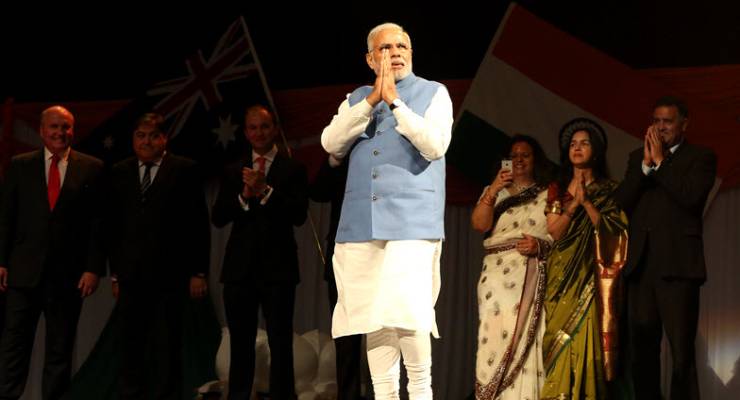
Next week voting starts in India’s national elections. But it’s a vote where a historically robust free journalism is increasingly constrained by the ruling party — as a government, as an advertiser and as an ideological voice.
As journalist Raksha Kumar wrote in the recent PEN International report: “speech is free in India as long as it conforms to a majoritarian perspective furthered by the establishment.”
This “majoritarian perspective” is cautious code for the populist Hindu nationalist (“Hindutva”) approach of the ruling Bharatiya Janata Party. It’s a practical manifestation of what Jan-Werner Müller described in What is Populism? as “a moralised form of antipluralism” where “only some of the people are really the people”.
For many Indians — particularly journalists and writers — it’s a shocking shift from traditional secular pluralism, respecting minorities, including that 10% of the world’s Muslims who live in the country. For Australians, it’s a warning of how quickly a free media can be undermined.
As with Trump’s trope, journalists who criticise the people’s government must, by definition, be the “enemy of the people”. Unleashing the people against these enemies has already proved fatal. According to the Indian journalists group Free Speech Collective:
In 2018, seven journalists were killed in relation to their work, at least 27 incidents of attacks on 33 journalists took place, there were arrests of at least 10 journalists and the detention of six others (including three foreign journalists), at least 17 instances of threats and harassment and 114 instances of censorship of news, film, academia, cultural events and public meetings.
Driving that ideological shift has been a multi-faceted political exercise, involving using the state, the party and the Hindutva movement. Apart from the violence and harassment, its tactics range from disciplining journalists for being anti-national, directing government advertising to supportive media, the buy-out of regional (and usually non-English) media by government supporters and self-censorship by mainstream media.
At the national level, Prime Minister Narendra Modi uses social media as his major communication tool. Unlike Trump, the Modi stream is relatively disciplined, backed up by an inner circle (who can be more intemperate) and then amplified with increasing virulence by supporters.
Since his 2014 election, Modi has never held a press conference. Journalist requests for comment are almost always referred by the government’s press officers to statements made on Facebook or Twitter.
A Reuters industry report last month demonstrated the extent to which Indian news has become a mobile and platform-based world. In a survey for the report, 68% of English speakers identified smartphones as the major device for accessing news. An overwhelming majority identified the tech platforms as their major news source. Only 18% considered news sites as their primary source of news.
Outside the control of platform content moderators, the messaging platform WhatsApp has been used to share inflammatory messages from group to group. According to the Reuters report, 52% of respondents cite WhatsApp as their major news source. As a result, WhatsApp has introduced limits on sharing and methods to monitor hate speech in that closed (and end-to-end encrypted) platform.
Some traditional media, such as The Hindu, has stood against the tide — and the gap being left by traditional media is being filled in part by online (and largely English language) news media such as The Wire, Scroll and media critic News Laundry. But despite their journalistic quality, they have limited reach.
This election year, the temperature has gone up as much of the Indian media has welcomed militarism into the nationalist discourse, following the car-bombing of a militarised police convoy near Pulwama in Kashmir in February, killing about 40. Blaming the Pakistan-based Jaish-e-Mohammed, India bombed a camp inside Pakistan.
Since then, the government has followed up with the successful test of a ground to space missile last week.
The media — particularly cable media — responded with the rhetoric and symbolism of war, including anchors appearing on screen in military fatigues, and carrying (admittedly, toy) weapons. Australians watching the recent third one-day international Australia-India match would have seen this militarism in play in popular culture as the Indian team wore army caps on the field.
Voting in the Indian election will run from April 11 to May 19. Votes will be counted and declared on May 23.








But India did not bomb a camp inside Pakistan. India claimed to have done so: but journalists on the ground have found that the bombs fell nowhere near a camp of any kind.
India claimed to have shot down a Pakistani fighter. This was cover after the embarrassment of having one of its own fighters shot down, over Pakistan, and the pilot ceremoniously handed back by Pakistan. No Pakistani fighter was shot down.
Under Imran Khan, Pakistan has now clamped down on a variety of militants including Jaish-e-Mohammed.
None of this affects the chauvinist Modi, who is safe to tell Indian voters whatever he likes, without fear of correction by the overwhelmingly chauvinist and overwhelmingly propagandistic Indian press.
“…the Indian team wore army caps on the field” Really? Why were they not disqualified and the match cancelled? What happened to the principle of not dragging politics into sport? When South Africa brought its apartheid policy into sport we boycotted them, and rightly so. The Indian players are a credit to their game but not when they misbehave like this.
Hmm, ““speech is free (…) as long as it conforms to a majoritarian perspective furthered by the establishment.”.
Why does this sound familiar? Couldn’t happen here… oh wait.